Developing Individuals, Teams, and Organisations Report - Module
VerifiedAdded on 2020/10/23
|13
|3824
|488
Report
AI Summary
This report examines the critical aspects of developing individuals, teams, and organizations. It begins by identifying the essential knowledge, skills, and behaviors required by human resource managers, including communication, leadership, and analytical abilities. A personal skills audit is analyzed to determine the necessary competencies for HR professionals. The report then differentiates between organizational and individual learning, training, and development, emphasizing the importance of continuous learning for sustainable business performance. It further explores how high-performance workers contribute to employee engagement and competitive advantage within an organizational context. Finally, the report evaluates different approaches to performance management, providing a comprehensive overview of the subject.
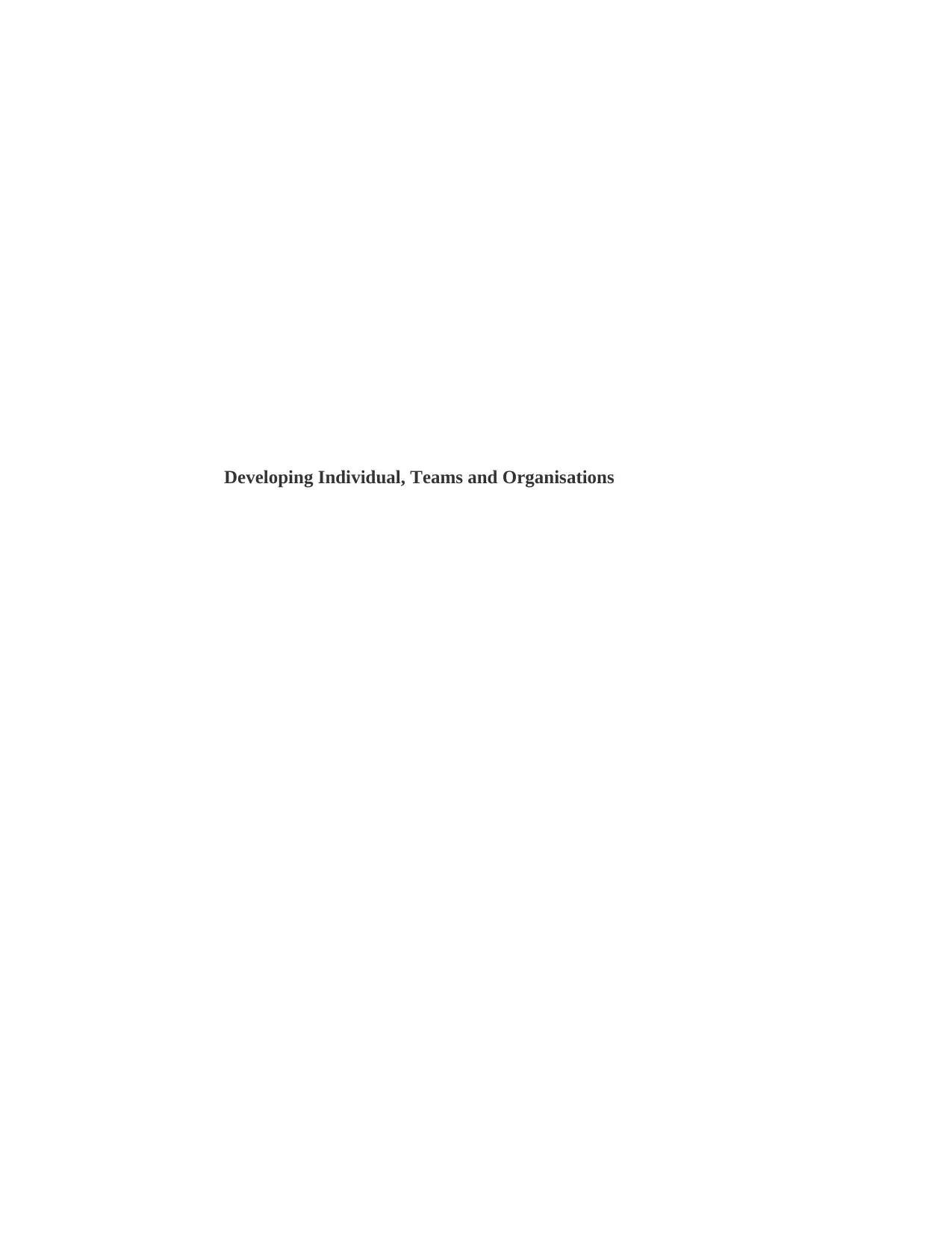
Developing Individual, Teams and Organisations
Paraphrase This Document
Need a fresh take? Get an instant paraphrase of this document with our AI Paraphraser
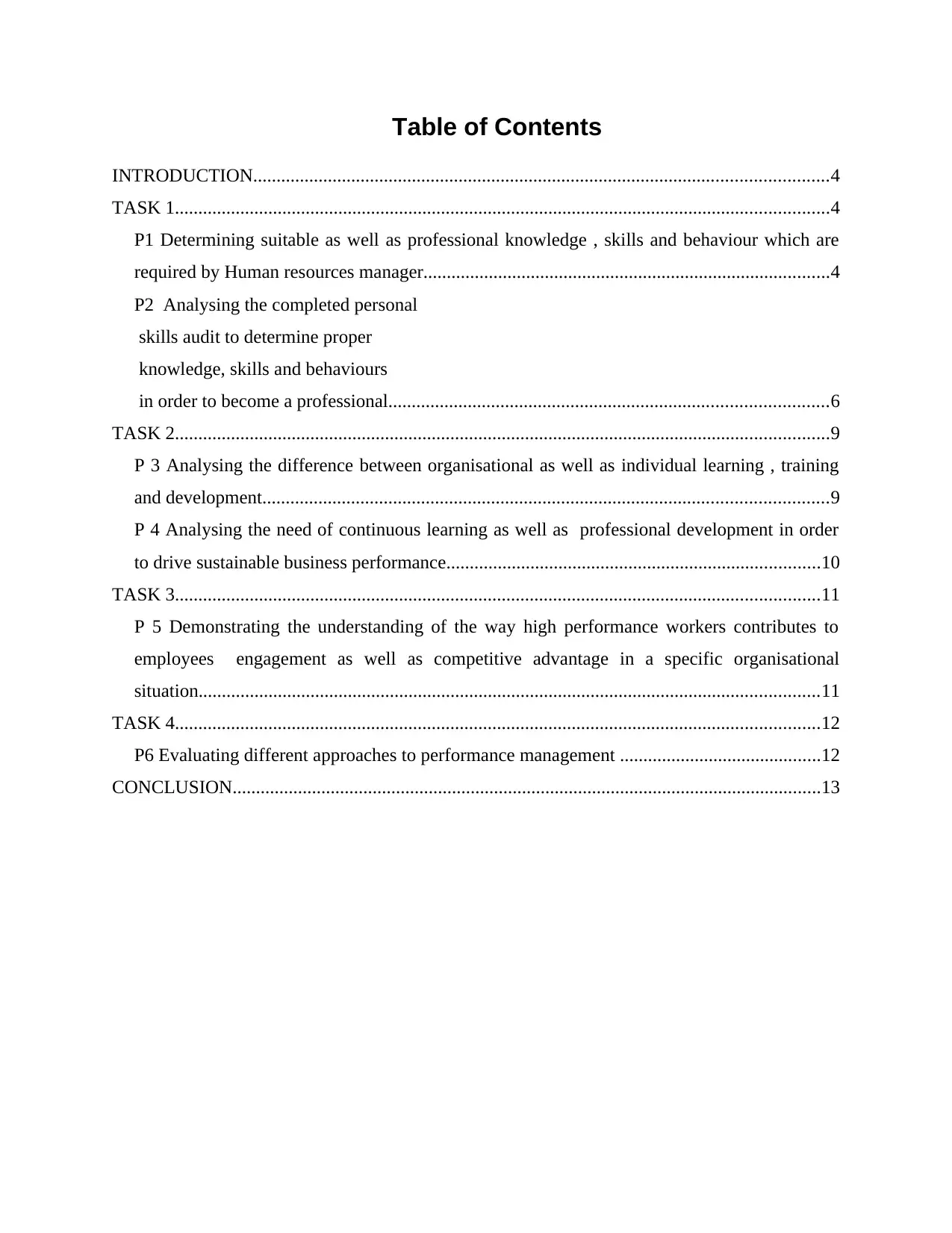
Table of Contents
INTRODUCTION...........................................................................................................................4
TASK 1............................................................................................................................................4
P1 Determining suitable as well as professional knowledge , skills and behaviour which are
required by Human resources manager.......................................................................................4
P2 Analysing the completed personal
skills audit to determine proper
knowledge, skills and behaviours
in order to become a professional..............................................................................................6
TASK 2............................................................................................................................................9
P 3 Analysing the difference between organisational as well as individual learning , training
and development.........................................................................................................................9
P 4 Analysing the need of continuous learning as well as professional development in order
to drive sustainable business performance................................................................................10
TASK 3..........................................................................................................................................11
P 5 Demonstrating the understanding of the way high performance workers contributes to
employees engagement as well as competitive advantage in a specific organisational
situation.....................................................................................................................................11
TASK 4..........................................................................................................................................12
P6 Evaluating different approaches to performance management ...........................................12
CONCLUSION..............................................................................................................................13
INTRODUCTION...........................................................................................................................4
TASK 1............................................................................................................................................4
P1 Determining suitable as well as professional knowledge , skills and behaviour which are
required by Human resources manager.......................................................................................4
P2 Analysing the completed personal
skills audit to determine proper
knowledge, skills and behaviours
in order to become a professional..............................................................................................6
TASK 2............................................................................................................................................9
P 3 Analysing the difference between organisational as well as individual learning , training
and development.........................................................................................................................9
P 4 Analysing the need of continuous learning as well as professional development in order
to drive sustainable business performance................................................................................10
TASK 3..........................................................................................................................................11
P 5 Demonstrating the understanding of the way high performance workers contributes to
employees engagement as well as competitive advantage in a specific organisational
situation.....................................................................................................................................11
TASK 4..........................................................................................................................................12
P6 Evaluating different approaches to performance management ...........................................12
CONCLUSION..............................................................................................................................13
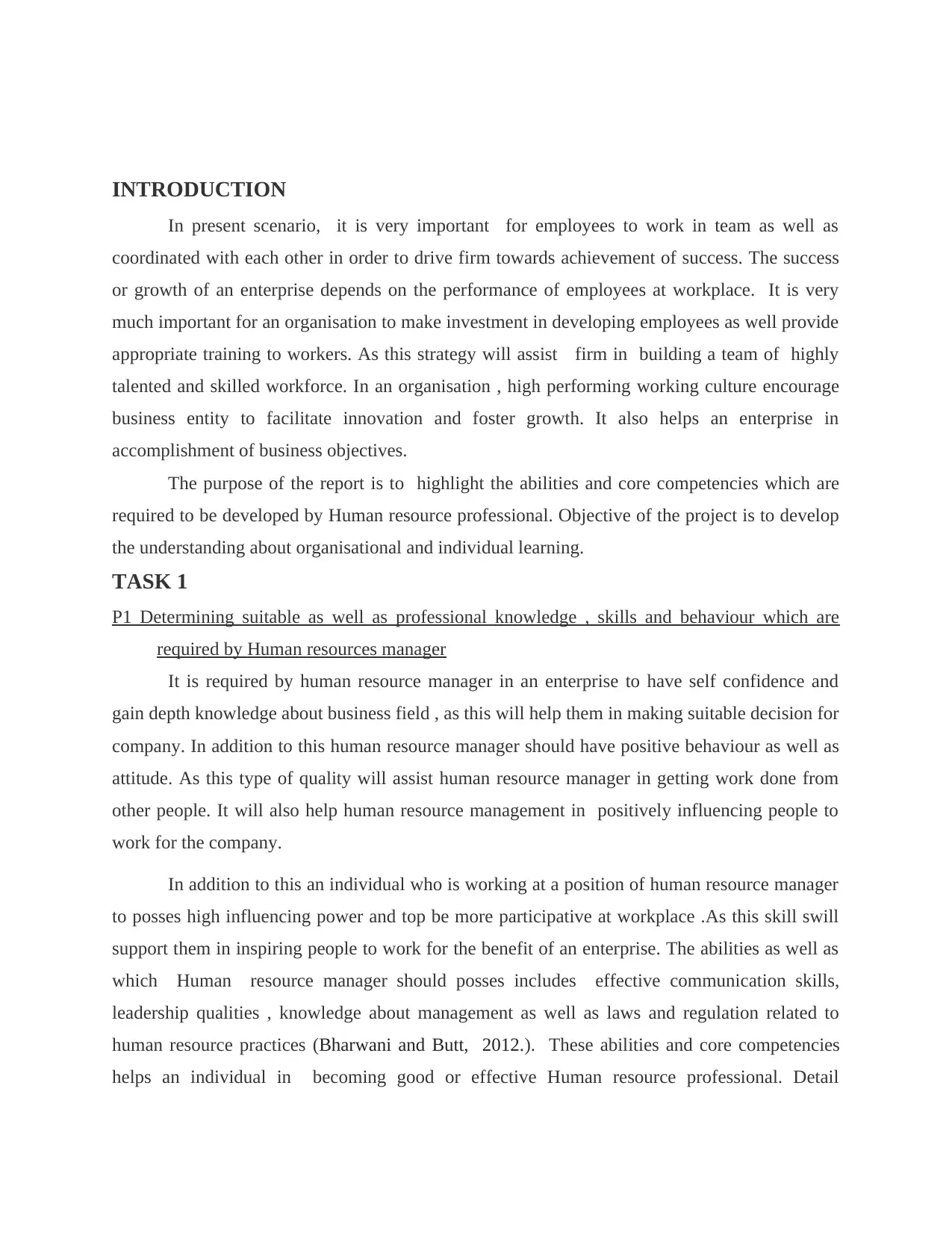
INTRODUCTION
In present scenario, it is very important for employees to work in team as well as
coordinated with each other in order to drive firm towards achievement of success. The success
or growth of an enterprise depends on the performance of employees at workplace. It is very
much important for an organisation to make investment in developing employees as well provide
appropriate training to workers. As this strategy will assist firm in building a team of highly
talented and skilled workforce. In an organisation , high performing working culture encourage
business entity to facilitate innovation and foster growth. It also helps an enterprise in
accomplishment of business objectives.
The purpose of the report is to highlight the abilities and core competencies which are
required to be developed by Human resource professional. Objective of the project is to develop
the understanding about organisational and individual learning.
TASK 1
P1 Determining suitable as well as professional knowledge , skills and behaviour which are
required by Human resources manager
It is required by human resource manager in an enterprise to have self confidence and
gain depth knowledge about business field , as this will help them in making suitable decision for
company. In addition to this human resource manager should have positive behaviour as well as
attitude. As this type of quality will assist human resource manager in getting work done from
other people. It will also help human resource management in positively influencing people to
work for the company.
In addition to this an individual who is working at a position of human resource manager
to posses high influencing power and top be more participative at workplace .As this skill swill
support them in inspiring people to work for the benefit of an enterprise. The abilities as well as
which Human resource manager should posses includes effective communication skills,
leadership qualities , knowledge about management as well as laws and regulation related to
human resource practices (Bharwani and Butt, 2012.). These abilities and core competencies
helps an individual in becoming good or effective Human resource professional. Detail
In present scenario, it is very important for employees to work in team as well as
coordinated with each other in order to drive firm towards achievement of success. The success
or growth of an enterprise depends on the performance of employees at workplace. It is very
much important for an organisation to make investment in developing employees as well provide
appropriate training to workers. As this strategy will assist firm in building a team of highly
talented and skilled workforce. In an organisation , high performing working culture encourage
business entity to facilitate innovation and foster growth. It also helps an enterprise in
accomplishment of business objectives.
The purpose of the report is to highlight the abilities and core competencies which are
required to be developed by Human resource professional. Objective of the project is to develop
the understanding about organisational and individual learning.
TASK 1
P1 Determining suitable as well as professional knowledge , skills and behaviour which are
required by Human resources manager
It is required by human resource manager in an enterprise to have self confidence and
gain depth knowledge about business field , as this will help them in making suitable decision for
company. In addition to this human resource manager should have positive behaviour as well as
attitude. As this type of quality will assist human resource manager in getting work done from
other people. It will also help human resource management in positively influencing people to
work for the company.
In addition to this an individual who is working at a position of human resource manager
to posses high influencing power and top be more participative at workplace .As this skill swill
support them in inspiring people to work for the benefit of an enterprise. The abilities as well as
which Human resource manager should posses includes effective communication skills,
leadership qualities , knowledge about management as well as laws and regulation related to
human resource practices (Bharwani and Butt, 2012.). These abilities and core competencies
helps an individual in becoming good or effective Human resource professional. Detail
⊘ This is a preview!⊘
Do you want full access?
Subscribe today to unlock all pages.

Trusted by 1+ million students worldwide
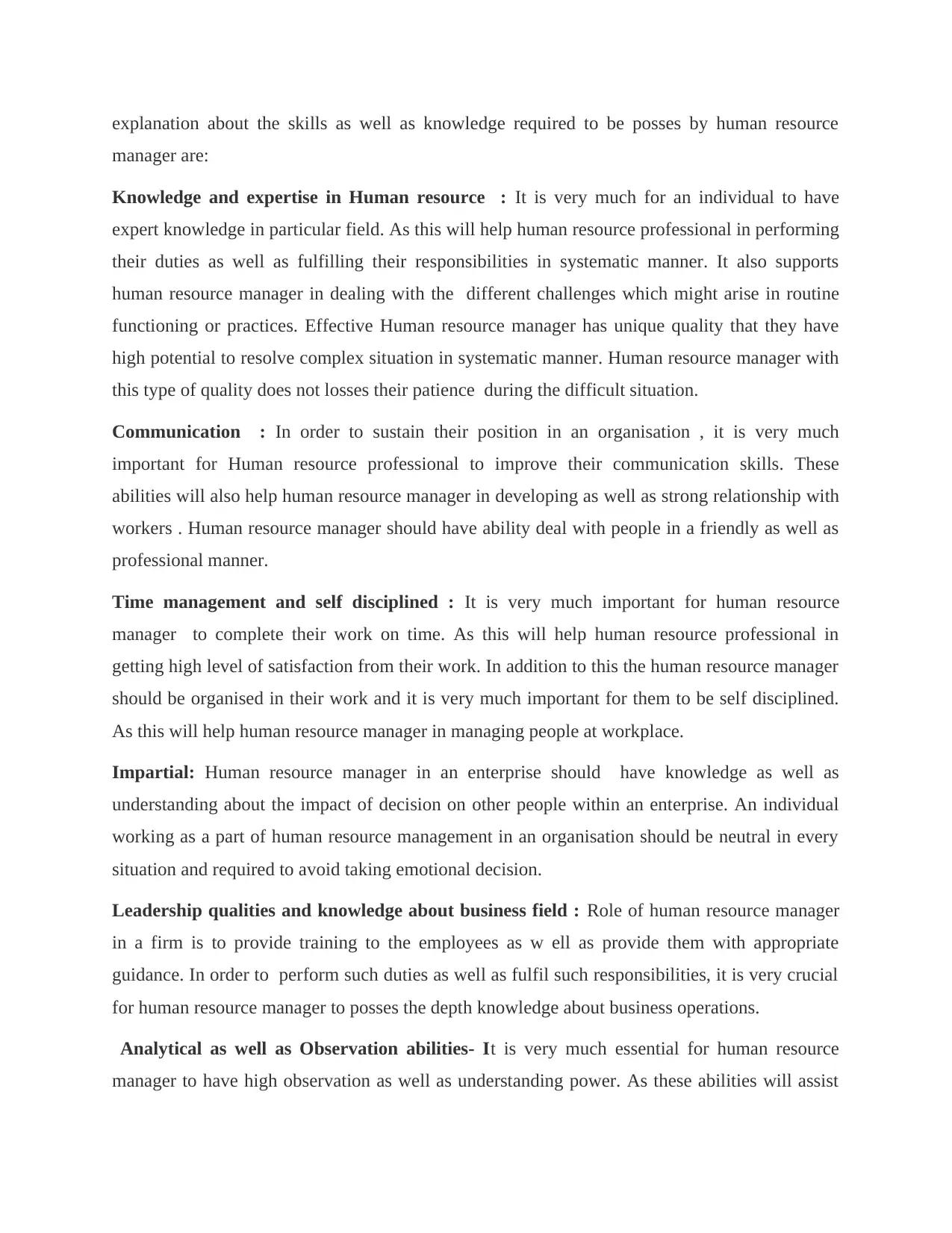
explanation about the skills as well as knowledge required to be posses by human resource
manager are:
Knowledge and expertise in Human resource : It is very much for an individual to have
expert knowledge in particular field. As this will help human resource professional in performing
their duties as well as fulfilling their responsibilities in systematic manner. It also supports
human resource manager in dealing with the different challenges which might arise in routine
functioning or practices. Effective Human resource manager has unique quality that they have
high potential to resolve complex situation in systematic manner. Human resource manager with
this type of quality does not losses their patience during the difficult situation.
Communication : In order to sustain their position in an organisation , it is very much
important for Human resource professional to improve their communication skills. These
abilities will also help human resource manager in developing as well as strong relationship with
workers . Human resource manager should have ability deal with people in a friendly as well as
professional manner.
Time management and self disciplined : It is very much important for human resource
manager to complete their work on time. As this will help human resource professional in
getting high level of satisfaction from their work. In addition to this the human resource manager
should be organised in their work and it is very much important for them to be self disciplined.
As this will help human resource manager in managing people at workplace.
Impartial: Human resource manager in an enterprise should have knowledge as well as
understanding about the impact of decision on other people within an enterprise. An individual
working as a part of human resource management in an organisation should be neutral in every
situation and required to avoid taking emotional decision.
Leadership qualities and knowledge about business field : Role of human resource manager
in a firm is to provide training to the employees as w ell as provide them with appropriate
guidance. In order to perform such duties as well as fulfil such responsibilities, it is very crucial
for human resource manager to posses the depth knowledge about business operations.
Analytical as well as Observation abilities- It is very much essential for human resource
manager to have high observation as well as understanding power. As these abilities will assist
manager are:
Knowledge and expertise in Human resource : It is very much for an individual to have
expert knowledge in particular field. As this will help human resource professional in performing
their duties as well as fulfilling their responsibilities in systematic manner. It also supports
human resource manager in dealing with the different challenges which might arise in routine
functioning or practices. Effective Human resource manager has unique quality that they have
high potential to resolve complex situation in systematic manner. Human resource manager with
this type of quality does not losses their patience during the difficult situation.
Communication : In order to sustain their position in an organisation , it is very much
important for Human resource professional to improve their communication skills. These
abilities will also help human resource manager in developing as well as strong relationship with
workers . Human resource manager should have ability deal with people in a friendly as well as
professional manner.
Time management and self disciplined : It is very much important for human resource
manager to complete their work on time. As this will help human resource professional in
getting high level of satisfaction from their work. In addition to this the human resource manager
should be organised in their work and it is very much important for them to be self disciplined.
As this will help human resource manager in managing people at workplace.
Impartial: Human resource manager in an enterprise should have knowledge as well as
understanding about the impact of decision on other people within an enterprise. An individual
working as a part of human resource management in an organisation should be neutral in every
situation and required to avoid taking emotional decision.
Leadership qualities and knowledge about business field : Role of human resource manager
in a firm is to provide training to the employees as w ell as provide them with appropriate
guidance. In order to perform such duties as well as fulfil such responsibilities, it is very crucial
for human resource manager to posses the depth knowledge about business operations.
Analytical as well as Observation abilities- It is very much essential for human resource
manager to have high observation as well as understanding power. As these abilities will assist
Paraphrase This Document
Need a fresh take? Get an instant paraphrase of this document with our AI Paraphraser
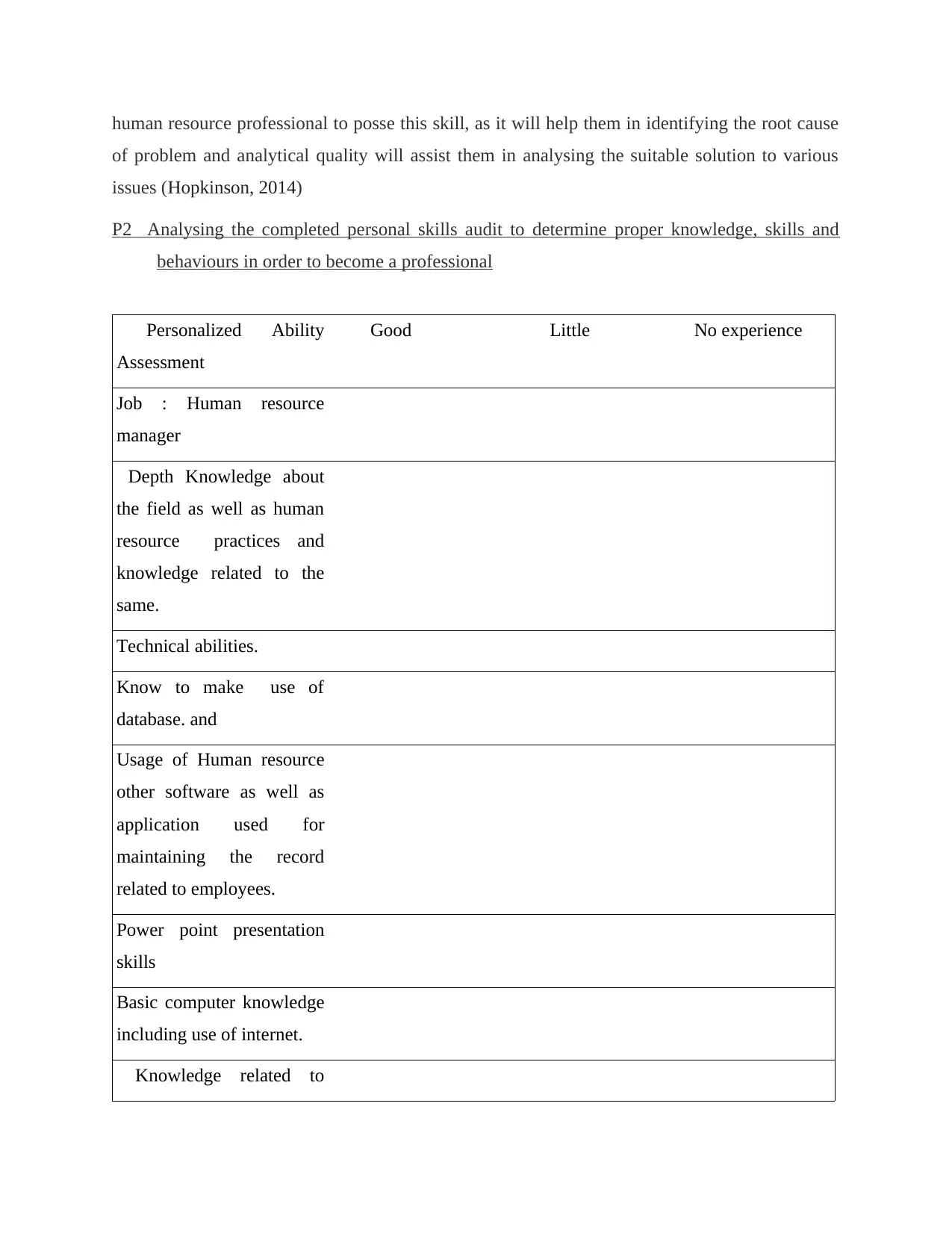
human resource professional to posse this skill, as it will help them in identifying the root cause
of problem and analytical quality will assist them in analysing the suitable solution to various
issues (Hopkinson, 2014)
P2 Analysing the completed personal skills audit to determine proper knowledge, skills and
behaviours in order to become a professional
Personalized Ability
Assessment
Good Little No experience
Job : Human resource
manager
Depth Knowledge about
the field as well as human
resource practices and
knowledge related to the
same.
Technical abilities.
Know to make use of
database. and
Usage of Human resource
other software as well as
application used for
maintaining the record
related to employees.
Power point presentation
skills
Basic computer knowledge
including use of internet.
Knowledge related to
of problem and analytical quality will assist them in analysing the suitable solution to various
issues (Hopkinson, 2014)
P2 Analysing the completed personal skills audit to determine proper knowledge, skills and
behaviours in order to become a professional
Personalized Ability
Assessment
Good Little No experience
Job : Human resource
manager
Depth Knowledge about
the field as well as human
resource practices and
knowledge related to the
same.
Technical abilities.
Know to make use of
database. and
Usage of Human resource
other software as well as
application used for
maintaining the record
related to employees.
Power point presentation
skills
Basic computer knowledge
including use of internet.
Knowledge related to
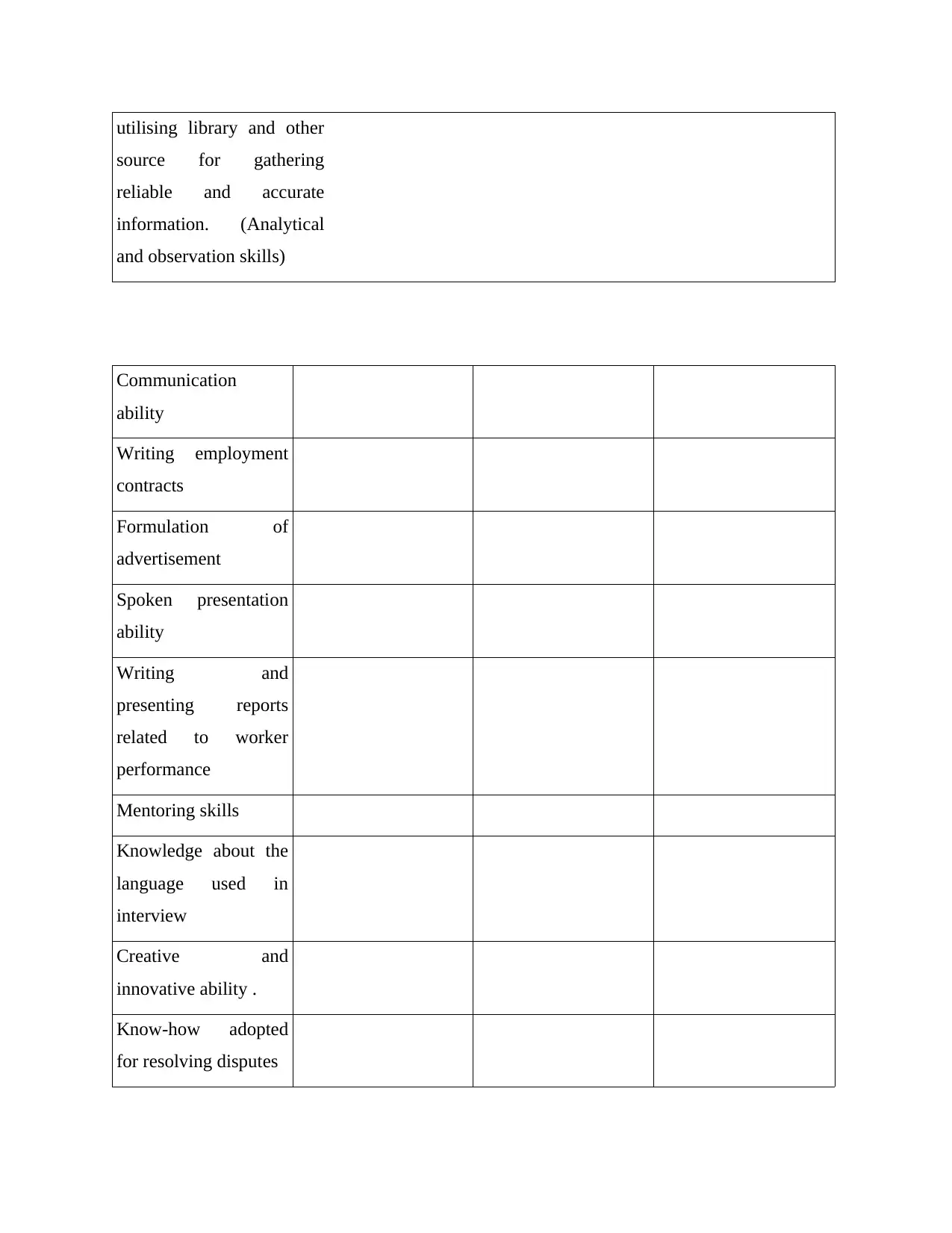
utilising library and other
source for gathering
reliable and accurate
information. (Analytical
and observation skills)
Communication
ability
Writing employment
contracts
Formulation of
advertisement
Spoken presentation
ability
Writing and
presenting reports
related to worker
performance
Mentoring skills
Knowledge about the
language used in
interview
Creative and
innovative ability .
Know-how adopted
for resolving disputes
source for gathering
reliable and accurate
information. (Analytical
and observation skills)
Communication
ability
Writing employment
contracts
Formulation of
advertisement
Spoken presentation
ability
Writing and
presenting reports
related to worker
performance
Mentoring skills
Knowledge about the
language used in
interview
Creative and
innovative ability .
Know-how adopted
for resolving disputes
⊘ This is a preview!⊘
Do you want full access?
Subscribe today to unlock all pages.

Trusted by 1+ million students worldwide
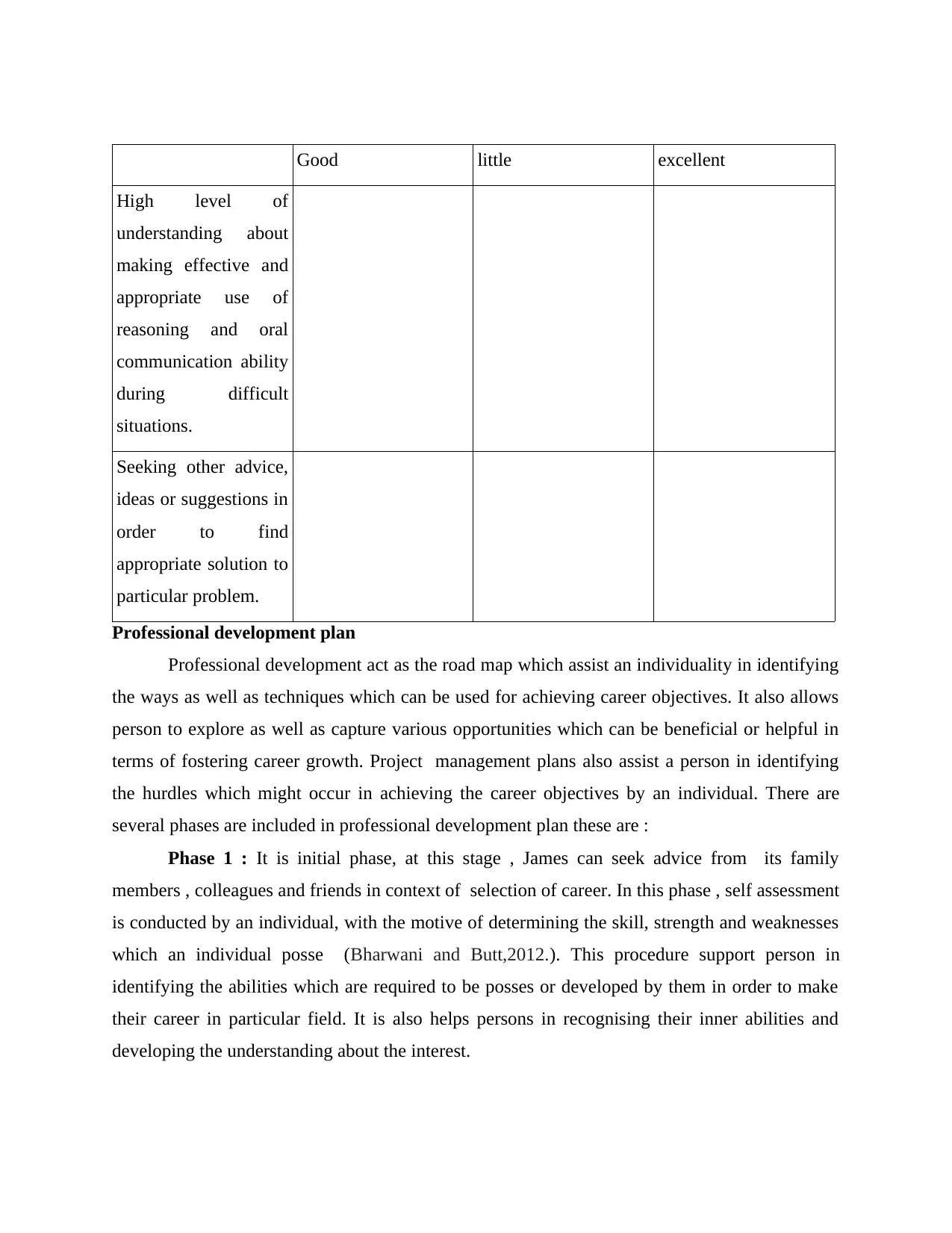
Good little excellent
High level of
understanding about
making effective and
appropriate use of
reasoning and oral
communication ability
during difficult
situations.
Seeking other advice,
ideas or suggestions in
order to find
appropriate solution to
particular problem.
Professional development plan
Professional development act as the road map which assist an individuality in identifying
the ways as well as techniques which can be used for achieving career objectives. It also allows
person to explore as well as capture various opportunities which can be beneficial or helpful in
terms of fostering career growth. Project management plans also assist a person in identifying
the hurdles which might occur in achieving the career objectives by an individual. There are
several phases are included in professional development plan these are :
Phase 1 : It is initial phase, at this stage , James can seek advice from its family
members , colleagues and friends in context of selection of career. In this phase , self assessment
is conducted by an individual, with the motive of determining the skill, strength and weaknesses
which an individual posse (Bharwani and Butt,2012.). This procedure support person in
identifying the abilities which are required to be posses or developed by them in order to make
their career in particular field. It is also helps persons in recognising their inner abilities and
developing the understanding about the interest.
High level of
understanding about
making effective and
appropriate use of
reasoning and oral
communication ability
during difficult
situations.
Seeking other advice,
ideas or suggestions in
order to find
appropriate solution to
particular problem.
Professional development plan
Professional development act as the road map which assist an individuality in identifying
the ways as well as techniques which can be used for achieving career objectives. It also allows
person to explore as well as capture various opportunities which can be beneficial or helpful in
terms of fostering career growth. Project management plans also assist a person in identifying
the hurdles which might occur in achieving the career objectives by an individual. There are
several phases are included in professional development plan these are :
Phase 1 : It is initial phase, at this stage , James can seek advice from its family
members , colleagues and friends in context of selection of career. In this phase , self assessment
is conducted by an individual, with the motive of determining the skill, strength and weaknesses
which an individual posse (Bharwani and Butt,2012.). This procedure support person in
identifying the abilities which are required to be posses or developed by them in order to make
their career in particular field. It is also helps persons in recognising their inner abilities and
developing the understanding about the interest.
Paraphrase This Document
Need a fresh take? Get an instant paraphrase of this document with our AI Paraphraser
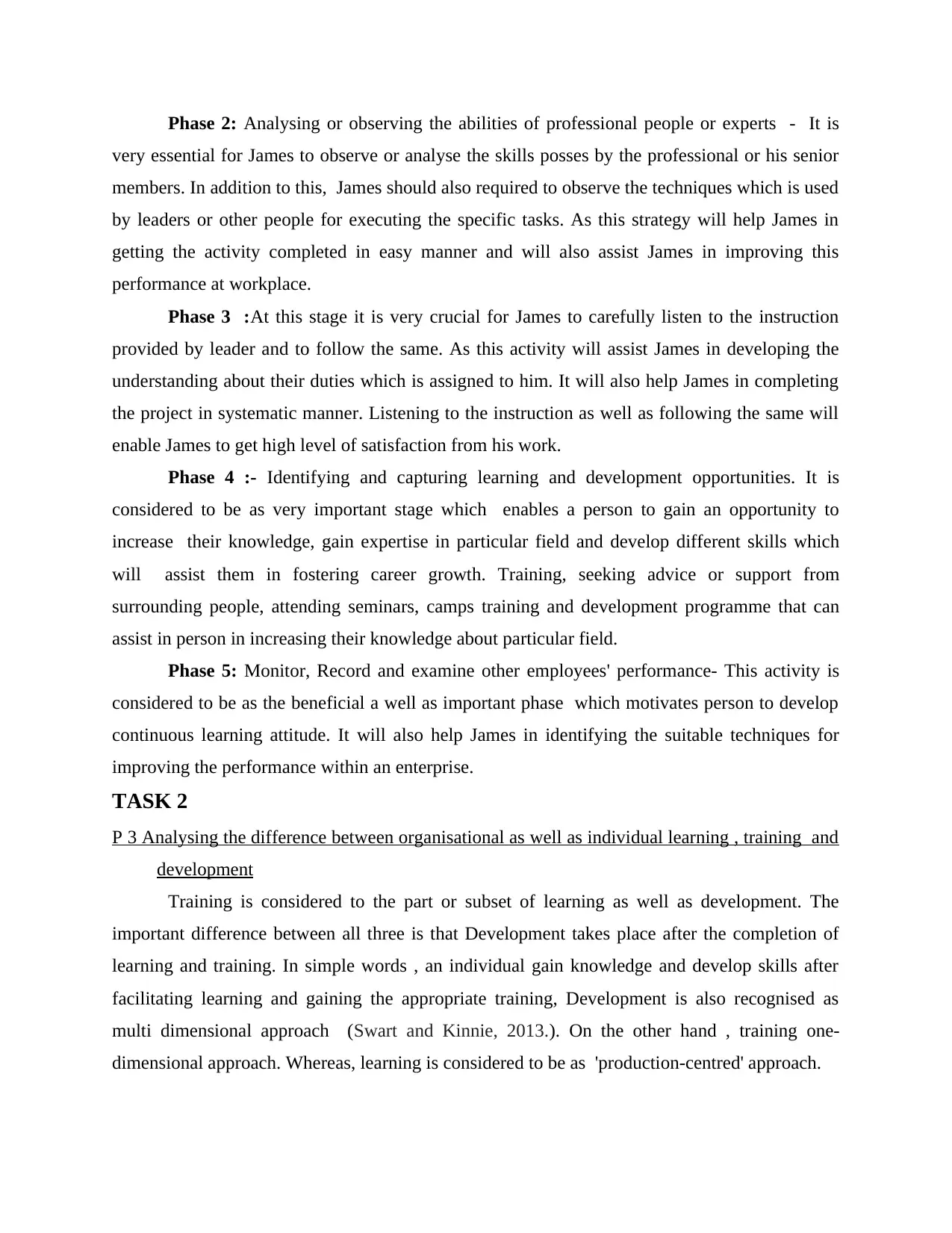
Phase 2: Analysing or observing the abilities of professional people or experts - It is
very essential for James to observe or analyse the skills posses by the professional or his senior
members. In addition to this, James should also required to observe the techniques which is used
by leaders or other people for executing the specific tasks. As this strategy will help James in
getting the activity completed in easy manner and will also assist James in improving this
performance at workplace.
Phase 3 :At this stage it is very crucial for James to carefully listen to the instruction
provided by leader and to follow the same. As this activity will assist James in developing the
understanding about their duties which is assigned to him. It will also help James in completing
the project in systematic manner. Listening to the instruction as well as following the same will
enable James to get high level of satisfaction from his work.
Phase 4 :- Identifying and capturing learning and development opportunities. It is
considered to be as very important stage which enables a person to gain an opportunity to
increase their knowledge, gain expertise in particular field and develop different skills which
will assist them in fostering career growth. Training, seeking advice or support from
surrounding people, attending seminars, camps training and development programme that can
assist in person in increasing their knowledge about particular field.
Phase 5: Monitor, Record and examine other employees' performance- This activity is
considered to be as the beneficial a well as important phase which motivates person to develop
continuous learning attitude. It will also help James in identifying the suitable techniques for
improving the performance within an enterprise.
TASK 2
P 3 Analysing the difference between organisational as well as individual learning , training and
development
Training is considered to the part or subset of learning as well as development. The
important difference between all three is that Development takes place after the completion of
learning and training. In simple words , an individual gain knowledge and develop skills after
facilitating learning and gaining the appropriate training, Development is also recognised as
multi dimensional approach (Swart and Kinnie, 2013.). On the other hand , training one-
dimensional approach. Whereas, learning is considered to be as 'production-centred' approach.
very essential for James to observe or analyse the skills posses by the professional or his senior
members. In addition to this, James should also required to observe the techniques which is used
by leaders or other people for executing the specific tasks. As this strategy will help James in
getting the activity completed in easy manner and will also assist James in improving this
performance at workplace.
Phase 3 :At this stage it is very crucial for James to carefully listen to the instruction
provided by leader and to follow the same. As this activity will assist James in developing the
understanding about their duties which is assigned to him. It will also help James in completing
the project in systematic manner. Listening to the instruction as well as following the same will
enable James to get high level of satisfaction from his work.
Phase 4 :- Identifying and capturing learning and development opportunities. It is
considered to be as very important stage which enables a person to gain an opportunity to
increase their knowledge, gain expertise in particular field and develop different skills which
will assist them in fostering career growth. Training, seeking advice or support from
surrounding people, attending seminars, camps training and development programme that can
assist in person in increasing their knowledge about particular field.
Phase 5: Monitor, Record and examine other employees' performance- This activity is
considered to be as the beneficial a well as important phase which motivates person to develop
continuous learning attitude. It will also help James in identifying the suitable techniques for
improving the performance within an enterprise.
TASK 2
P 3 Analysing the difference between organisational as well as individual learning , training and
development
Training is considered to the part or subset of learning as well as development. The
important difference between all three is that Development takes place after the completion of
learning and training. In simple words , an individual gain knowledge and develop skills after
facilitating learning and gaining the appropriate training, Development is also recognised as
multi dimensional approach (Swart and Kinnie, 2013.). On the other hand , training one-
dimensional approach. Whereas, learning is considered to be as 'production-centred' approach.
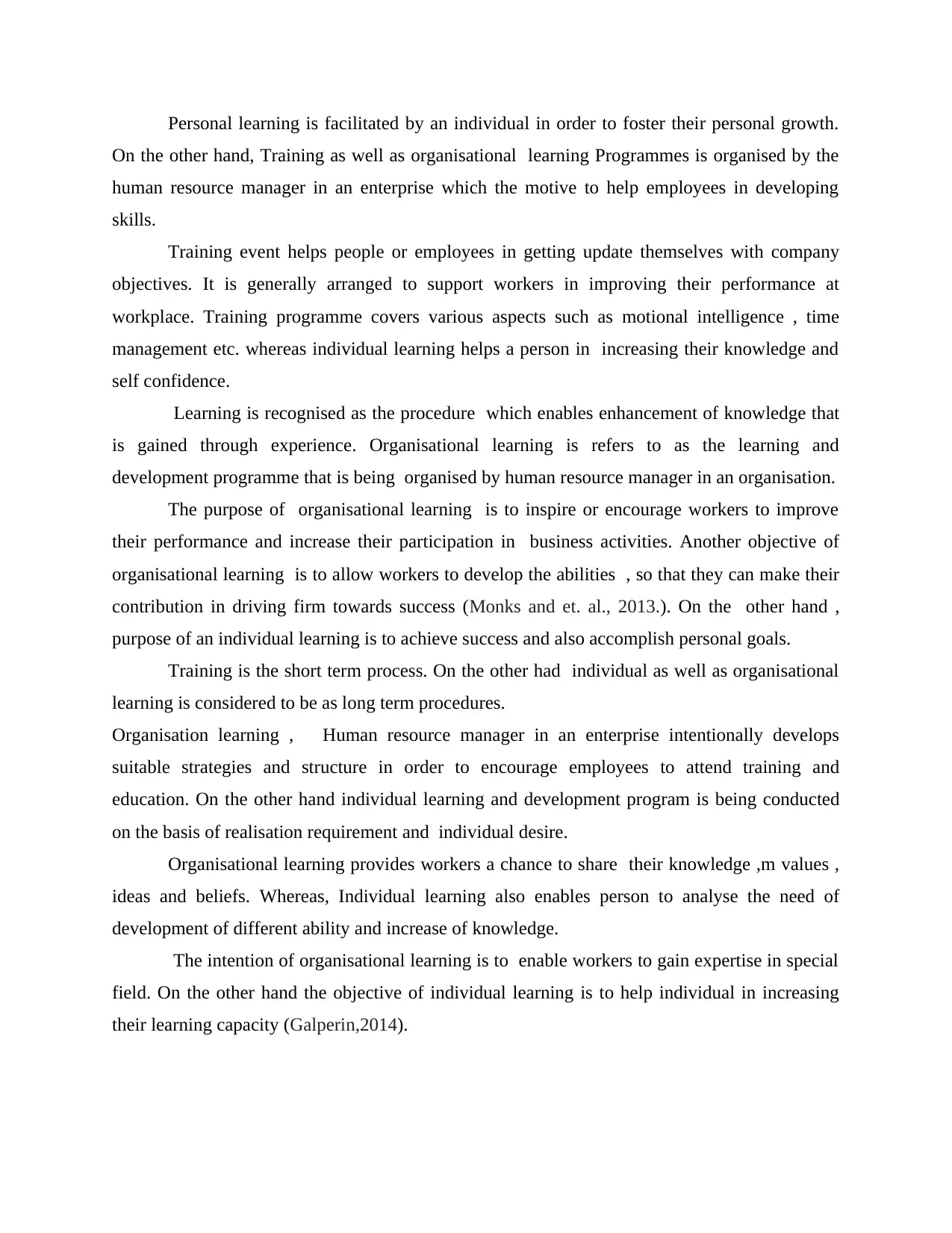
Personal learning is facilitated by an individual in order to foster their personal growth.
On the other hand, Training as well as organisational learning Programmes is organised by the
human resource manager in an enterprise which the motive to help employees in developing
skills.
Training event helps people or employees in getting update themselves with company
objectives. It is generally arranged to support workers in improving their performance at
workplace. Training programme covers various aspects such as motional intelligence , time
management etc. whereas individual learning helps a person in increasing their knowledge and
self confidence.
Learning is recognised as the procedure which enables enhancement of knowledge that
is gained through experience. Organisational learning is refers to as the learning and
development programme that is being organised by human resource manager in an organisation.
The purpose of organisational learning is to inspire or encourage workers to improve
their performance and increase their participation in business activities. Another objective of
organisational learning is to allow workers to develop the abilities , so that they can make their
contribution in driving firm towards success (Monks and et. al., 2013.). On the other hand ,
purpose of an individual learning is to achieve success and also accomplish personal goals.
Training is the short term process. On the other had individual as well as organisational
learning is considered to be as long term procedures.
Organisation learning , Human resource manager in an enterprise intentionally develops
suitable strategies and structure in order to encourage employees to attend training and
education. On the other hand individual learning and development program is being conducted
on the basis of realisation requirement and individual desire.
Organisational learning provides workers a chance to share their knowledge ,m values ,
ideas and beliefs. Whereas, Individual learning also enables person to analyse the need of
development of different ability and increase of knowledge.
The intention of organisational learning is to enable workers to gain expertise in special
field. On the other hand the objective of individual learning is to help individual in increasing
their learning capacity (Galperin,2014).
On the other hand, Training as well as organisational learning Programmes is organised by the
human resource manager in an enterprise which the motive to help employees in developing
skills.
Training event helps people or employees in getting update themselves with company
objectives. It is generally arranged to support workers in improving their performance at
workplace. Training programme covers various aspects such as motional intelligence , time
management etc. whereas individual learning helps a person in increasing their knowledge and
self confidence.
Learning is recognised as the procedure which enables enhancement of knowledge that
is gained through experience. Organisational learning is refers to as the learning and
development programme that is being organised by human resource manager in an organisation.
The purpose of organisational learning is to inspire or encourage workers to improve
their performance and increase their participation in business activities. Another objective of
organisational learning is to allow workers to develop the abilities , so that they can make their
contribution in driving firm towards success (Monks and et. al., 2013.). On the other hand ,
purpose of an individual learning is to achieve success and also accomplish personal goals.
Training is the short term process. On the other had individual as well as organisational
learning is considered to be as long term procedures.
Organisation learning , Human resource manager in an enterprise intentionally develops
suitable strategies and structure in order to encourage employees to attend training and
education. On the other hand individual learning and development program is being conducted
on the basis of realisation requirement and individual desire.
Organisational learning provides workers a chance to share their knowledge ,m values ,
ideas and beliefs. Whereas, Individual learning also enables person to analyse the need of
development of different ability and increase of knowledge.
The intention of organisational learning is to enable workers to gain expertise in special
field. On the other hand the objective of individual learning is to help individual in increasing
their learning capacity (Galperin,2014).
⊘ This is a preview!⊘
Do you want full access?
Subscribe today to unlock all pages.

Trusted by 1+ million students worldwide
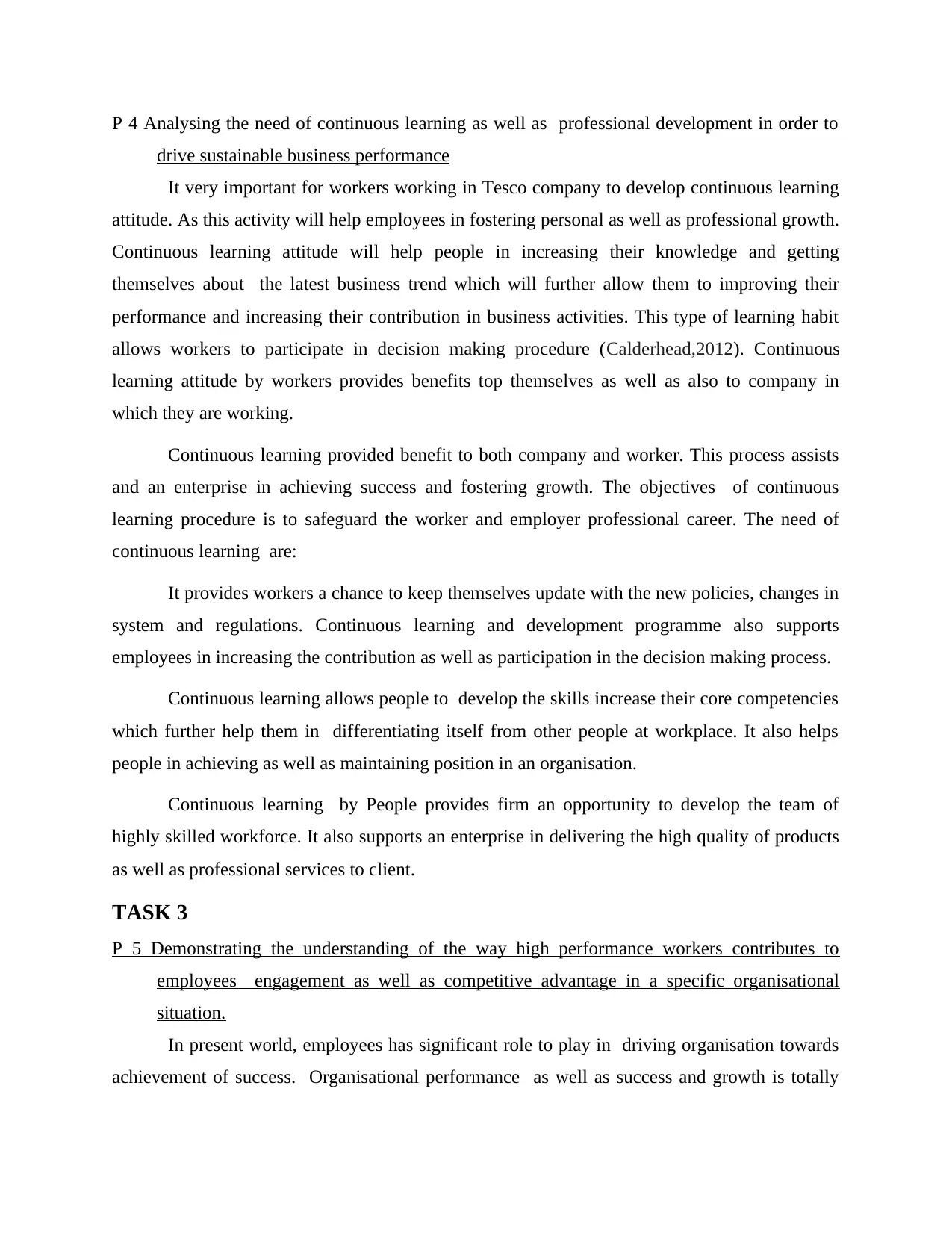
P 4 Analysing the need of continuous learning as well as professional development in order to
drive sustainable business performance
It very important for workers working in Tesco company to develop continuous learning
attitude. As this activity will help employees in fostering personal as well as professional growth.
Continuous learning attitude will help people in increasing their knowledge and getting
themselves about the latest business trend which will further allow them to improving their
performance and increasing their contribution in business activities. This type of learning habit
allows workers to participate in decision making procedure (Calderhead,2012). Continuous
learning attitude by workers provides benefits top themselves as well as also to company in
which they are working.
Continuous learning provided benefit to both company and worker. This process assists
and an enterprise in achieving success and fostering growth. The objectives of continuous
learning procedure is to safeguard the worker and employer professional career. The need of
continuous learning are:
It provides workers a chance to keep themselves update with the new policies, changes in
system and regulations. Continuous learning and development programme also supports
employees in increasing the contribution as well as participation in the decision making process.
Continuous learning allows people to develop the skills increase their core competencies
which further help them in differentiating itself from other people at workplace. It also helps
people in achieving as well as maintaining position in an organisation.
Continuous learning by People provides firm an opportunity to develop the team of
highly skilled workforce. It also supports an enterprise in delivering the high quality of products
as well as professional services to client.
TASK 3
P 5 Demonstrating the understanding of the way high performance workers contributes to
employees engagement as well as competitive advantage in a specific organisational
situation.
In present world, employees has significant role to play in driving organisation towards
achievement of success. Organisational performance as well as success and growth is totally
drive sustainable business performance
It very important for workers working in Tesco company to develop continuous learning
attitude. As this activity will help employees in fostering personal as well as professional growth.
Continuous learning attitude will help people in increasing their knowledge and getting
themselves about the latest business trend which will further allow them to improving their
performance and increasing their contribution in business activities. This type of learning habit
allows workers to participate in decision making procedure (Calderhead,2012). Continuous
learning attitude by workers provides benefits top themselves as well as also to company in
which they are working.
Continuous learning provided benefit to both company and worker. This process assists
and an enterprise in achieving success and fostering growth. The objectives of continuous
learning procedure is to safeguard the worker and employer professional career. The need of
continuous learning are:
It provides workers a chance to keep themselves update with the new policies, changes in
system and regulations. Continuous learning and development programme also supports
employees in increasing the contribution as well as participation in the decision making process.
Continuous learning allows people to develop the skills increase their core competencies
which further help them in differentiating itself from other people at workplace. It also helps
people in achieving as well as maintaining position in an organisation.
Continuous learning by People provides firm an opportunity to develop the team of
highly skilled workforce. It also supports an enterprise in delivering the high quality of products
as well as professional services to client.
TASK 3
P 5 Demonstrating the understanding of the way high performance workers contributes to
employees engagement as well as competitive advantage in a specific organisational
situation.
In present world, employees has significant role to play in driving organisation towards
achievement of success. Organisational performance as well as success and growth is totally
Paraphrase This Document
Need a fresh take? Get an instant paraphrase of this document with our AI Paraphraser
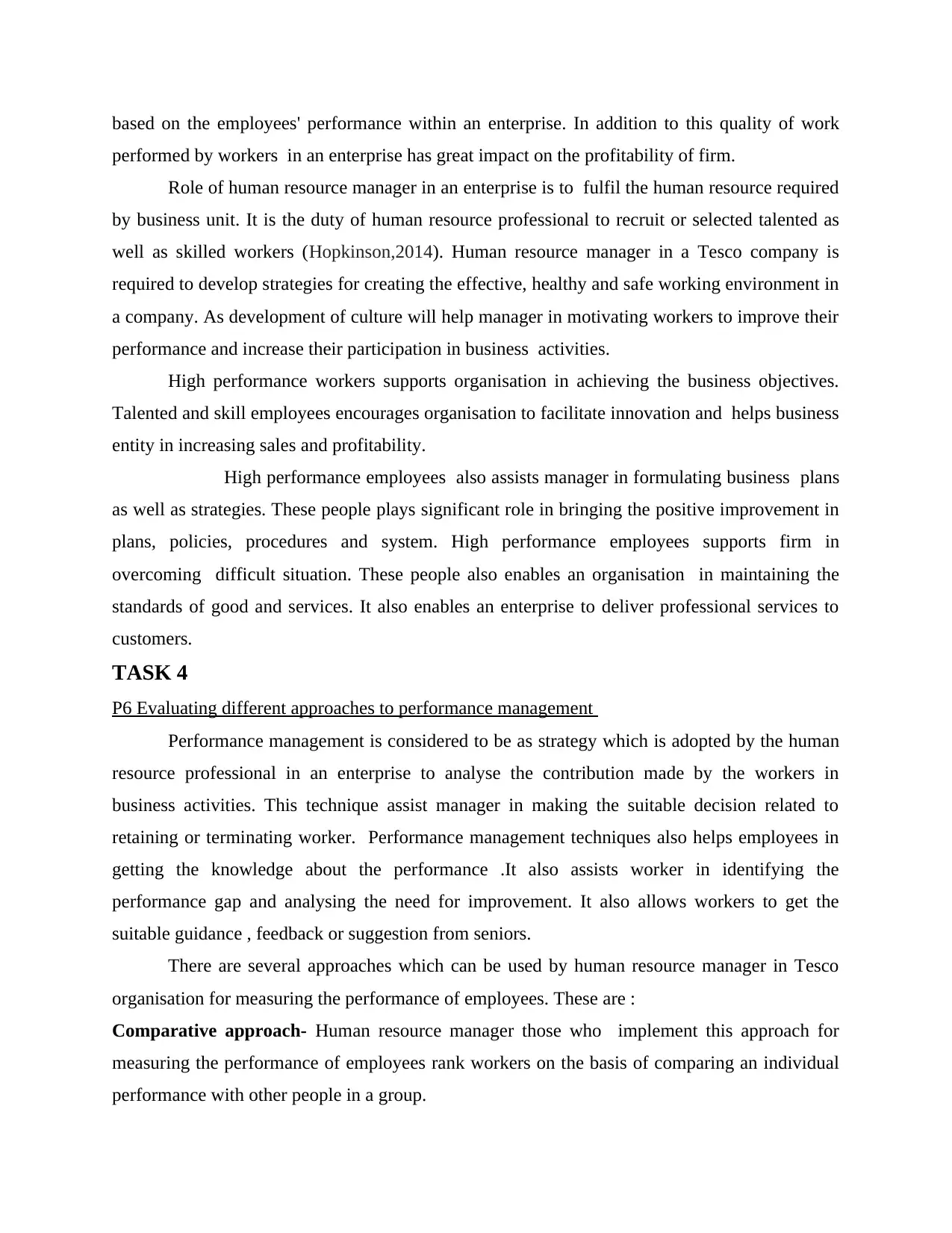
based on the employees' performance within an enterprise. In addition to this quality of work
performed by workers in an enterprise has great impact on the profitability of firm.
Role of human resource manager in an enterprise is to fulfil the human resource required
by business unit. It is the duty of human resource professional to recruit or selected talented as
well as skilled workers (Hopkinson,2014). Human resource manager in a Tesco company is
required to develop strategies for creating the effective, healthy and safe working environment in
a company. As development of culture will help manager in motivating workers to improve their
performance and increase their participation in business activities.
High performance workers supports organisation in achieving the business objectives.
Talented and skill employees encourages organisation to facilitate innovation and helps business
entity in increasing sales and profitability.
High performance employees also assists manager in formulating business plans
as well as strategies. These people plays significant role in bringing the positive improvement in
plans, policies, procedures and system. High performance employees supports firm in
overcoming difficult situation. These people also enables an organisation in maintaining the
standards of good and services. It also enables an enterprise to deliver professional services to
customers.
TASK 4
P6 Evaluating different approaches to performance management
Performance management is considered to be as strategy which is adopted by the human
resource professional in an enterprise to analyse the contribution made by the workers in
business activities. This technique assist manager in making the suitable decision related to
retaining or terminating worker. Performance management techniques also helps employees in
getting the knowledge about the performance .It also assists worker in identifying the
performance gap and analysing the need for improvement. It also allows workers to get the
suitable guidance , feedback or suggestion from seniors.
There are several approaches which can be used by human resource manager in Tesco
organisation for measuring the performance of employees. These are :
Comparative approach- Human resource manager those who implement this approach for
measuring the performance of employees rank workers on the basis of comparing an individual
performance with other people in a group.
performed by workers in an enterprise has great impact on the profitability of firm.
Role of human resource manager in an enterprise is to fulfil the human resource required
by business unit. It is the duty of human resource professional to recruit or selected talented as
well as skilled workers (Hopkinson,2014). Human resource manager in a Tesco company is
required to develop strategies for creating the effective, healthy and safe working environment in
a company. As development of culture will help manager in motivating workers to improve their
performance and increase their participation in business activities.
High performance workers supports organisation in achieving the business objectives.
Talented and skill employees encourages organisation to facilitate innovation and helps business
entity in increasing sales and profitability.
High performance employees also assists manager in formulating business plans
as well as strategies. These people plays significant role in bringing the positive improvement in
plans, policies, procedures and system. High performance employees supports firm in
overcoming difficult situation. These people also enables an organisation in maintaining the
standards of good and services. It also enables an enterprise to deliver professional services to
customers.
TASK 4
P6 Evaluating different approaches to performance management
Performance management is considered to be as strategy which is adopted by the human
resource professional in an enterprise to analyse the contribution made by the workers in
business activities. This technique assist manager in making the suitable decision related to
retaining or terminating worker. Performance management techniques also helps employees in
getting the knowledge about the performance .It also assists worker in identifying the
performance gap and analysing the need for improvement. It also allows workers to get the
suitable guidance , feedback or suggestion from seniors.
There are several approaches which can be used by human resource manager in Tesco
organisation for measuring the performance of employees. These are :
Comparative approach- Human resource manager those who implement this approach for
measuring the performance of employees rank workers on the basis of comparing an individual
performance with other people in a group.
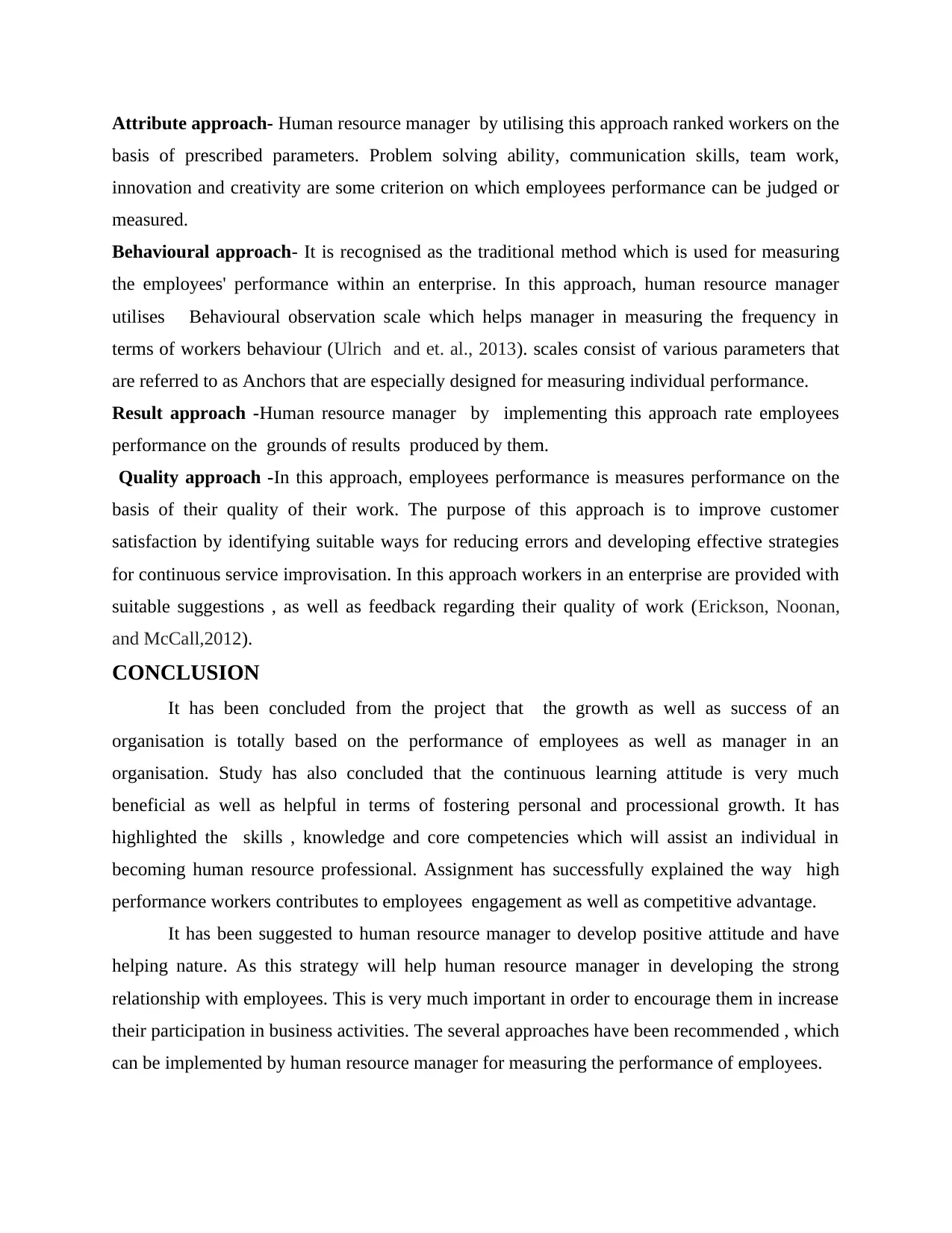
Attribute approach- Human resource manager by utilising this approach ranked workers on the
basis of prescribed parameters. Problem solving ability, communication skills, team work,
innovation and creativity are some criterion on which employees performance can be judged or
measured.
Behavioural approach- It is recognised as the traditional method which is used for measuring
the employees' performance within an enterprise. In this approach, human resource manager
utilises Behavioural observation scale which helps manager in measuring the frequency in
terms of workers behaviour (Ulrich and et. al., 2013). scales consist of various parameters that
are referred to as Anchors that are especially designed for measuring individual performance.
Result approach -Human resource manager by implementing this approach rate employees
performance on the grounds of results produced by them.
Quality approach -In this approach, employees performance is measures performance on the
basis of their quality of their work. The purpose of this approach is to improve customer
satisfaction by identifying suitable ways for reducing errors and developing effective strategies
for continuous service improvisation. In this approach workers in an enterprise are provided with
suitable suggestions , as well as feedback regarding their quality of work (Erickson, Noonan,
and McCall,2012).
CONCLUSION
It has been concluded from the project that the growth as well as success of an
organisation is totally based on the performance of employees as well as manager in an
organisation. Study has also concluded that the continuous learning attitude is very much
beneficial as well as helpful in terms of fostering personal and processional growth. It has
highlighted the skills , knowledge and core competencies which will assist an individual in
becoming human resource professional. Assignment has successfully explained the way high
performance workers contributes to employees engagement as well as competitive advantage.
It has been suggested to human resource manager to develop positive attitude and have
helping nature. As this strategy will help human resource manager in developing the strong
relationship with employees. This is very much important in order to encourage them in increase
their participation in business activities. The several approaches have been recommended , which
can be implemented by human resource manager for measuring the performance of employees.
basis of prescribed parameters. Problem solving ability, communication skills, team work,
innovation and creativity are some criterion on which employees performance can be judged or
measured.
Behavioural approach- It is recognised as the traditional method which is used for measuring
the employees' performance within an enterprise. In this approach, human resource manager
utilises Behavioural observation scale which helps manager in measuring the frequency in
terms of workers behaviour (Ulrich and et. al., 2013). scales consist of various parameters that
are referred to as Anchors that are especially designed for measuring individual performance.
Result approach -Human resource manager by implementing this approach rate employees
performance on the grounds of results produced by them.
Quality approach -In this approach, employees performance is measures performance on the
basis of their quality of their work. The purpose of this approach is to improve customer
satisfaction by identifying suitable ways for reducing errors and developing effective strategies
for continuous service improvisation. In this approach workers in an enterprise are provided with
suitable suggestions , as well as feedback regarding their quality of work (Erickson, Noonan,
and McCall,2012).
CONCLUSION
It has been concluded from the project that the growth as well as success of an
organisation is totally based on the performance of employees as well as manager in an
organisation. Study has also concluded that the continuous learning attitude is very much
beneficial as well as helpful in terms of fostering personal and processional growth. It has
highlighted the skills , knowledge and core competencies which will assist an individual in
becoming human resource professional. Assignment has successfully explained the way high
performance workers contributes to employees engagement as well as competitive advantage.
It has been suggested to human resource manager to develop positive attitude and have
helping nature. As this strategy will help human resource manager in developing the strong
relationship with employees. This is very much important in order to encourage them in increase
their participation in business activities. The several approaches have been recommended , which
can be implemented by human resource manager for measuring the performance of employees.
⊘ This is a preview!⊘
Do you want full access?
Subscribe today to unlock all pages.

Trusted by 1+ million students worldwide
1 out of 13
Related Documents
Your All-in-One AI-Powered Toolkit for Academic Success.
+13062052269
info@desklib.com
Available 24*7 on WhatsApp / Email
![[object Object]](/_next/static/media/star-bottom.7253800d.svg)
Unlock your academic potential
Copyright © 2020–2025 A2Z Services. All Rights Reserved. Developed and managed by ZUCOL.





